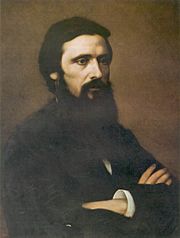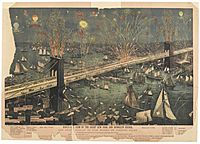John Aaron Rawlins facts for kids
Quick facts for kids
John Rawlins
|
|
|---|---|
 |
|
| 29th United States Secretary of War | |
| In office March 13, 1869 – September 6, 1869 |
|
| President | Ulysses S. Grant |
| Preceded by | John Schofield |
| Succeeded by | William Tecumseh Sherman (acting) |
| Personal details | |
| Born |
John Aaron Rawlins
February 13, 1831 Galena, Illinois, U.S. |
| Died | September 6, 1869 (aged 38) Washington, D.C., U.S. |
| Resting place | Arlington National Cemetery |
| Political party | Democratic (Before 1868) Republican (1868–1869) |
| Spouses | Emily Smith (1856–1861) Emma Hurlburt (1863–1874) |
| Children | 6 |
| Signature | |
| Military service | |
| Allegiance | |
| Branch/service | • Union Army |
| Years of service | 1861–1869 |
| Rank | |
| Battles/wars | American Civil War |
John Aaron Rawlins (February 13, 1831 – September 6, 1869) was an important general in the Union Army during the American Civil War. He later became a cabinet member in President Ulysses S. Grant's government. Rawlins was a close friend and trusted advisor to Grant throughout the war. He rose to the rank of major general. After Grant became President, Rawlins was appointed Secretary of War.
Rawlins came from a poor family and had little formal schooling. He taught himself law and became a lawyer in Galena, Illinois, in 1854. When the Civil War began, he strongly supported the Union. He became good friends with Ulysses S. Grant, who was also from Galena. Rawlins convinced Grant to help train a local volunteer army group. Rawlins then joined the Union Army and served as an officer on Grant's staff. His promotions were linked to Grant's success in battles. Rawlins became ill in 1863 but continued to serve.
After Grant won the 1868 election, he chose Rawlins as his Secretary of War in March 1869. Rawlins supported Cuba's fight for independence from Spain. He also set up a policy for the Utah Territory. Rawlins' illness got worse, and he died in September 1869, just five months into his term.
Contents
Early Life and Education
John Aaron Rawlins was born on February 13, 1831, in East Galena, Illinois. He was the second of ten children. His parents, James Dawson and Lovisa Collier Rawlins, were of Scotch-Irish descent. His father was a farmer and charcoal maker.
In 1849, James Rawlins went to California during the California Gold Rush and stayed for three years. While his father was away, John took care of his mother and siblings. His father did not find gold, so John took on more responsibility for the family.
Rawlins had little formal education. He went to local schools and spent some time at Rock River Seminary. He was known as a "self-made man" because he studied on his own to make up for his lack of schooling. He then studied law and became a lawyer in 1854. Rawlins was a member of the Democratic Party.
His Family and Health
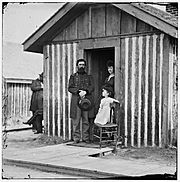
On June 5, 1856, Rawlins married Emily Smith. They had three children: James, Jennie, and Emily. Emily died in August 1861 from tuberculosis, shortly after Rawlins joined the Union Army. This made Rawlins fear he would also get the disease.
On December 23, 1863, Rawlins married Mary Emma Hurlburt. During the winter of 1863, Rawlins developed a cough. It was later diagnosed as tuberculosis.
Serving in the American Civil War
A Strong Supporter of the Union
After the attack on Fort Sumter started the American Civil War, people in Galena held a town meeting. Rawlins spoke there and made his support for the Union very clear. He said that the war was not about politics, but about whether the country would survive. He believed it was time to stand by the flag.
Rising Through the Ranks
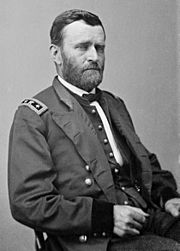
In 1861, Rawlins helped organize the 45th Illinois Infantry. Grant volunteered to help train this group. Grant was soon made commander of the 21st Illinois Volunteer Infantry Regiment. He asked Rawlins to be his assistant. Rawlins agreed and became a captain in the Army on August 30.
From then on, Rawlins stayed with Grant. He became Grant's most important staff officer, advisor, and friend. Rawlins was not formally trained in the military, but he was very good at his job. As Grant gained higher ranks, Rawlins also received promotions. He became Chief of Staff for different armies under Grant. He was known for paying close attention to details and following rules.
Rawlins was promoted to major on May 14, 1862, and to lieutenant colonel on November 1. He became a brigadier general of Volunteers on August 11, 1863. When Grant became the general in chief of all Union armies, Rawlins became Chief of Staff of the entire United States Army. He was promoted to major general on February 24, 1865.
Meeting President Lincoln
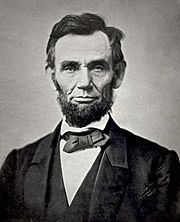
In the summer of 1863, Grant sent Rawlins to Washington D.C. to represent him. At this time, Grant was not well known in political circles. Rawlins met with General-In-Chief Henry W. Halleck and then with President Abraham Lincoln and his Cabinet.
Rawlins gave Lincoln a letter from Grant. He explained Grant's victory in the Vicksburg Campaign. People like Charles A. Dana and Secretary of Navy Gideon Welles praised Rawlins for being hardworking and smart.
Secretary of War
Important Decisions as Secretary
When Grant became President, Rawlins' doctors suggested he move to Arizona for his health. Grant wanted to make Rawlins a military commander there, but Rawlins wanted to stay with Grant. So, Grant appointed him Secretary of War.
During his five months in office, Rawlins had some disagreements with Secretary of State Hamilton Fish. Rawlins wanted to help Cuban rebels fight against Spain, even with military aid. Fish disagreed. Grant eventually sided with Fish, and the U.S. did not get involved.
Rawlins also convinced Grant to take a firm approach with the Mormons in Utah Territory. He believed they were rebelling over the issue of polygamy. Rawlins' health continued to get worse. He was bedridden before he died on September 6, 1869.
One of his last actions as Secretary of War was approving the construction of the Brooklyn Bridge.
Approving the Brooklyn Bridge
One of Rawlins' final acts was approving the building of the Brooklyn Bridge. This was a big project to connect Manhattan and Brooklyn over the East River. There was a disagreement about how high the bridge should be. Shipping companies wanted it high enough for large ships to pass under. The bridge builders wanted it lower.
Even though Rawlins was very ill, he carefully reviewed the plans for several days. He decided the bridge's maximum height would be 135 feet above the water. Construction began a few months later. Rawlins died soon after, but the Brooklyn Bridge was finished in 1883. It is still one of the oldest working bridges in the United States.
His Final Days
By late August 1869, Rawlins' tuberculosis was very advanced. He was staying at his home in Connecticut when he had a bleeding episode. He still traveled to Washington for a cabinet meeting. He had more bleeding episodes but made it to the meeting.
The next day, Rawlins had a long meeting with President Grant. Grant said goodbye to his friend. Rawlins was cared for by another friend, Ely S. Parker. On September 6, 1869, Secretary of War Rawlins died. Grant arrived too late to see him. Rawlins was buried in Arlington National Cemetery.
Legacy
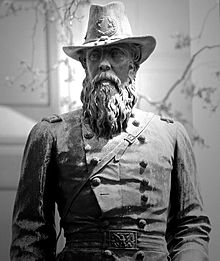
A statue of John Aaron Rawlins was put up in Washington, D.C. in 1874. Several places are named after him, including Rawlins Township, Jo Daviess County, Illinois, the town of Rawlins, Wyoming, and Rawlins County, Kansas. A coast artillery battery at Fort Flagler State Park was named after Rawlins in 1906.
Military Appointments
- Captain Assistant Military Adjutant General of Volunteers August 30, 1861
- Major and Assistant Adjutant General of Volunteers May 14, 1862
- Brigadier General of Volunteers August 11, 1863
- Brigadier General United States Army and Chief of Staff to the Major General Commanding March 3, 1865
- Major General United States Army April 9, 1865
- Resigned March 12, 1869
- Total military service time: 7 years, 6 months, 13 days
See also
 In Spanish: John Aaron Rawlins para niños
In Spanish: John Aaron Rawlins para niños


